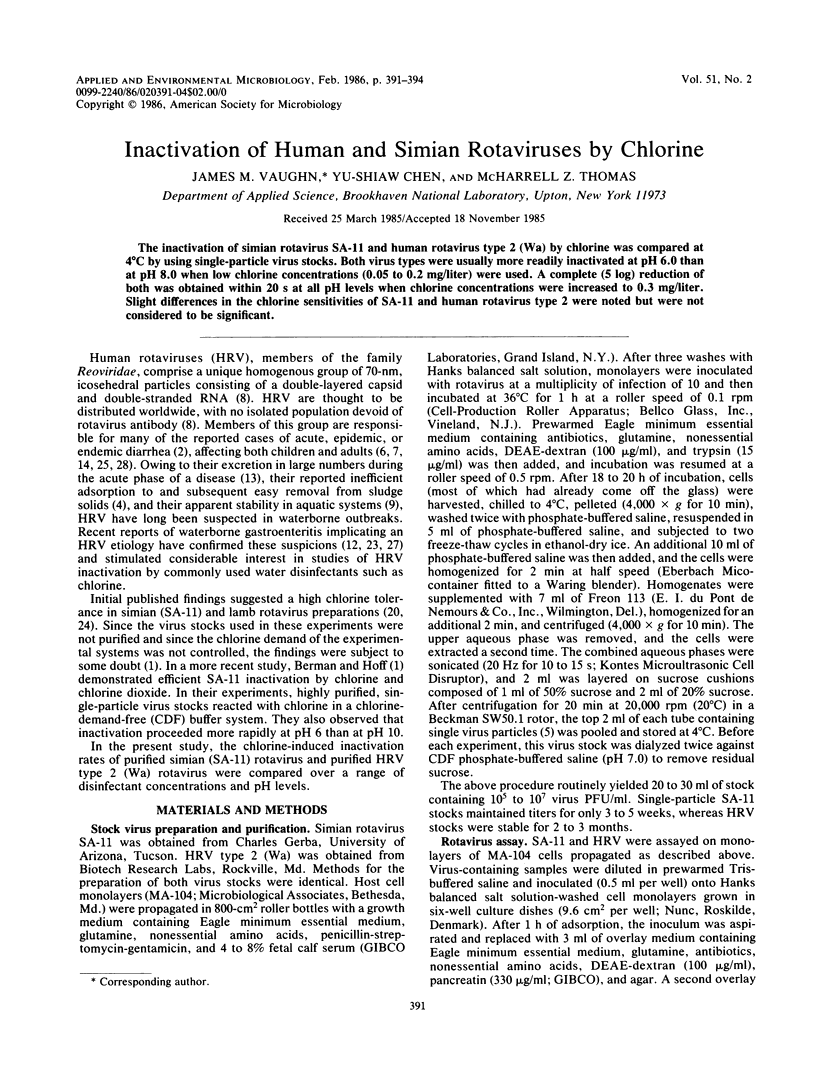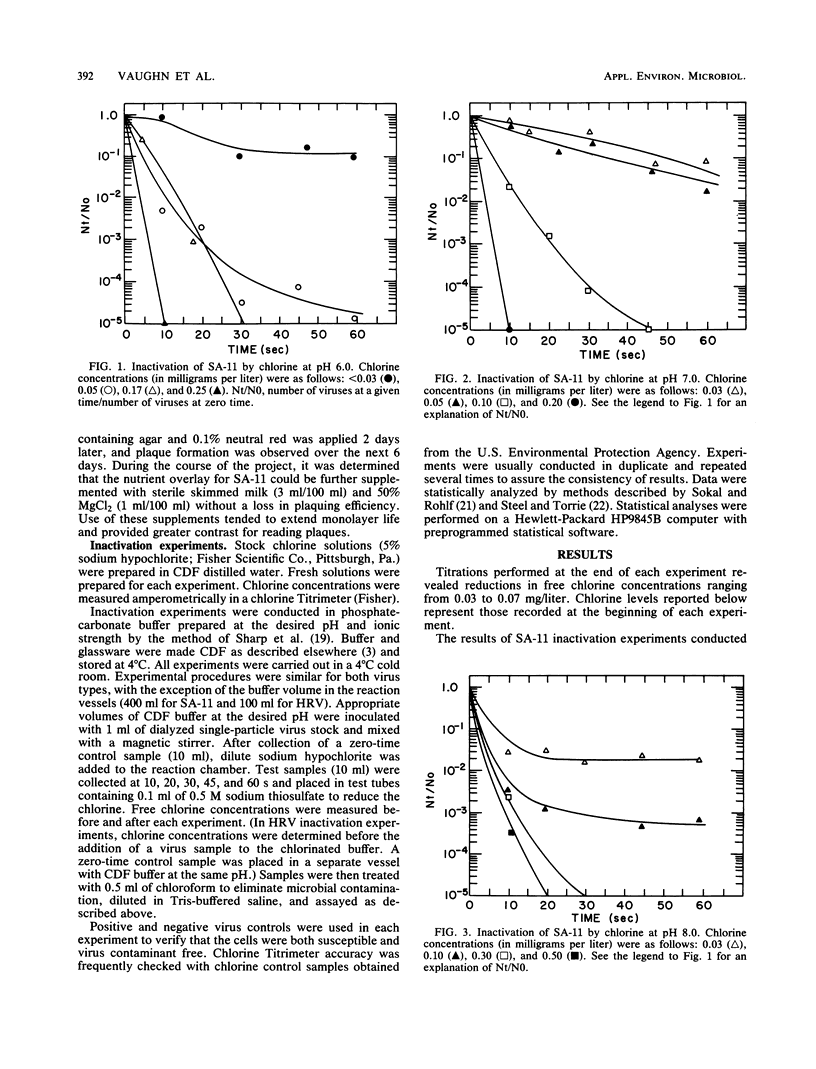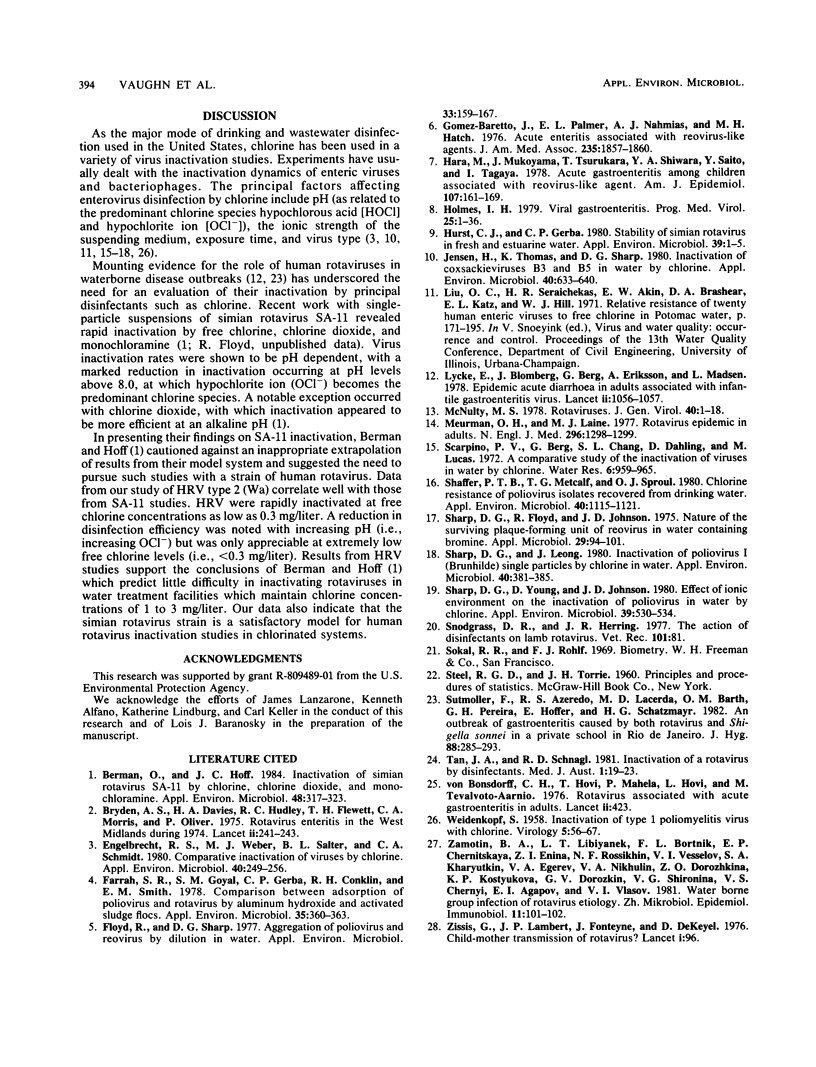Abstract
The inactivation of simian rotavirus SA-11 and human rotavirus type 2 (Wa) by chlorine was compared at 4 degrees C by using single-particle virus stocks. Both virus types were usually more readily inactivated at pH 6.0 than at pH 8.0 when low chlorine concentrations (0.05 to 0.2 mg/liter) were used. A complete (5 log) reduction of both was obtained within 20 s at all pH levels when chlorine concentrations were increased to 0.3 mg/liter. Slight differences in the chlorine sensitivities of SA-11 and human rotavirus type 2 were noted but were not considered to be significant.
Full text
PDF



Selected References
These references are in PubMed. This may not be the complete list of references from this article.
- Berman D., Hoff J. C. Inactivation of simian rotavirus SA11 by chlorine, chlorine dioxide, and monochloramine. Appl Environ Microbiol. 1984 Aug;48(2):317–323. doi: 10.1128/aem.48.2.317-323.1984. [DOI] [PMC free article] [PubMed] [Google Scholar]
- Bryden A. S., Davies H. A., Hadley R. E., Flewett T. H. Rotavirus enteritis in the West Midlands during 1974. Lancet. 1975 Aug 9;2(7928):241–243. doi: 10.1016/S0140-6736(75)90959-9. [DOI] [PMC free article] [PubMed] [Google Scholar]
- Engelbrecht R. S., Weber M. J., Salter B. L., Schmidt C. A. Comparative inactivation of viruses by chlorine. Appl Environ Microbiol. 1980 Aug;40(2):249–256. doi: 10.1128/aem.40.2.249-256.1980. [DOI] [PMC free article] [PubMed] [Google Scholar]
- Farrah S. R., Goyal S. M., Gerba C. P., Conklin R. H., Smith E. M. Comparison between adsorption of poliovirus and rotavirus by aluminum hydroxide and activated sludge flocs. Appl Environ Microbiol. 1978 Feb;35(2):360–363. doi: 10.1128/aem.35.2.360-363.1978. [DOI] [PMC free article] [PubMed] [Google Scholar]
- Floyd R., Sharp D. G. Aggregation of poliovirus and reovirus by dilution in water. Appl Environ Microbiol. 1977 Jan;33(1):159–167. doi: 10.1128/aem.33.1.159-167.1977. [DOI] [PMC free article] [PubMed] [Google Scholar]
- Gomez-Barreto J., Palmer E. L., Nahmias A. J., Hatch M. H. Acute enteritis associated with reovirus-like agents. JAMA. 1976 Apr 26;235(17):1857–1860. [PubMed] [Google Scholar]
- Hara M., Mukoyama J., Tsuruhara T., Ashiwara Y., Saito Y., Tagaya I. Acute gastroenteritis among schoolchildren associated with reovirus-like agent. Am J Epidemiol. 1978 Feb;107(2):161–169. doi: 10.1093/oxfordjournals.aje.a112518. [DOI] [PubMed] [Google Scholar]
- Holmes I. H. Viral gastroenteritis. Prog Med Virol. 1979;25:1–36. [PubMed] [Google Scholar]
- Hurst C. J., Gerba C. P. Stability of simian rotavirus in fresh and estuarine water. Appl Environ Microbiol. 1980 Jan;39(1):1–5. doi: 10.1128/aem.39.1.1-5.1980. [DOI] [PMC free article] [PubMed] [Google Scholar]
- Jensen H., Thomas K., Sharp D. G. Inactivation of coxsackieviruses B3 and B5 in water by chlorine. Appl Environ Microbiol. 1980 Sep;40(3):633–640. doi: 10.1128/aem.40.3.633-640.1980. [DOI] [PMC free article] [PubMed] [Google Scholar]
- Lycke E., Blomberg J., Berg G., Eriksson A., Madsen L. Epidemic acute diarrhoea in adults associated with infantile gastroenteritis virus. Lancet. 1978 Nov 11;2(8098):1056–1057. doi: 10.1016/s0140-6736(78)92389-9. [DOI] [PubMed] [Google Scholar]
- McNulty M. S. Rotaviruses. J Gen Virol. 1978 Jul;40(1):1–18. doi: 10.1099/0022-1317-40-1-1. [DOI] [PubMed] [Google Scholar]
- Meurman O. H., Laine M. J. Rotavirus epidemic in adults. N Engl J Med. 1977 Jun 2;296(22):1298–1299. doi: 10.1056/NEJM197706022962220. [DOI] [PubMed] [Google Scholar]
- Shaffer P. T., Metcalf T. G., Sproul O. J. Chlorine resistance of poliovirus isolants recovered from drinking water. Appl Environ Microbiol. 1980 Dec;40(6):1115–1121. doi: 10.1128/aem.40.6.1115-1121.1980. [DOI] [PMC free article] [PubMed] [Google Scholar]
- Sharp D. G., Floyd R., Johnson J. D. Nature of the surviving plaque-forming unit of reovirus in water containing bromine. Appl Microbiol. 1975 Jan;29(1):94–101. doi: 10.1128/am.29.1.94-101.1975. [DOI] [PMC free article] [PubMed] [Google Scholar]
- Sharp D. G., Leong J. Inactivation of poliovirus I (Brunhilde) single particles by chlorine in water. Appl Environ Microbiol. 1980 Aug;40(2):381–385. doi: 10.1128/aem.40.2.381-385.1980. [DOI] [PMC free article] [PubMed] [Google Scholar]
- Sharp D. G., Young D. C., Floyd R., Johnson J. D. Effect of ionic environment on the inactivation of poliovirus in water by chlorine. Appl Environ Microbiol. 1980 Mar;39(3):530–534. doi: 10.1128/aem.39.3.530-534.1980. [DOI] [PMC free article] [PubMed] [Google Scholar]
- Snodgrass D. R., Herring J. A. The action of disinfectants on lamb rotavirus. Vet Rec. 1977 Jul 23;101(4):81–81. doi: 10.1136/vr.101.4.81-a. [DOI] [PubMed] [Google Scholar]
- Sutmoller F., Azeredo R. S., Lacerda M. D., Barth O. M., Pereira H. G., Hoffer E., Schatzmayr H. G. An outbreak of gastroenteritis caused by both rotavirus and Shigella sonnei in a private school in Rio de Janeiro. J Hyg (Lond) 1982 Apr;88(2):285–293. doi: 10.1017/s0022172400070145. [DOI] [PMC free article] [PubMed] [Google Scholar]
- Tan J. A., Schnagl R. D. Inactivation of a rotavirus by disinfectants. Med J Aust. 1981 Jan 10;1(1):19–23. doi: 10.5694/j.1326-5377.1981.tb135281.x. [DOI] [PubMed] [Google Scholar]
- WEIDENKOPF S. J. Inactivation of type 1, poliomyelitis virus with chlorine. Virology. 1958 Feb;5(1):56–67. doi: 10.1016/0042-6822(58)90005-9. [DOI] [PubMed] [Google Scholar]
- von Bonsdorff C. H., Hovi T., Mákelá P., Hovi T., Tevalvoto-Aarnio M. Rotavirus associated with acute gastroenteritis in adults. Lancet. 1976 Aug 21;2(7982):423–423. doi: 10.1016/s0140-6736(76)92445-4. [DOI] [PubMed] [Google Scholar]


